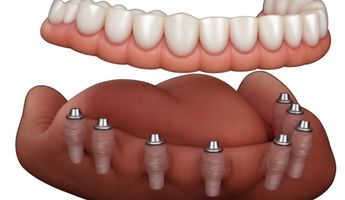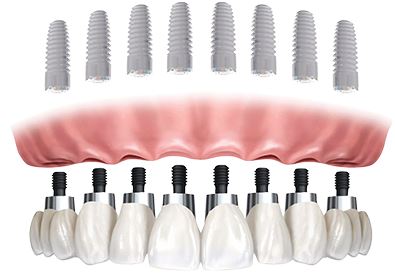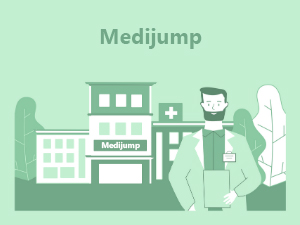All-on-8 in France
Search and Compare the Best Clinics and Doctors at the Lowest Prices for All-on-8 in France

Find the best clinics for All-on-8 in France
No clinics available
Turkey offers the best prices Worldwide
Price: $ 2,408

- Home
- France
WHY US?
At Medijump, we're making medical easy. You can search, compare, discuss, and book your medical all in one place. We open the door to the best medical providers worldwide, saving you time and energy along the way, and it's all for FREE, no hidden fees, and no price markups guaranteed. So what are you waiting for?

Free

Best Price

Widest Selection

Risk-Free
What do you need to know about All-on-8 in France?

All-on-8 is a powerful, state-of-the-art method designed to replace lost or damaged teeth. It entails the strategic placement of eight robust titanium posts into your jawbone. Following this, a complete set of teeth, usually fashioned from high-quality porcelain or acrylic, is securely fixed onto these posts. As affirmed by the National Institutes of Health, the procedure provides a durable solution for individuals grappling with significant tooth loss or decay, thereby dramatically improving their dental health and overall life experience.
Bear in mind that the procedure necessitates a substantial level of bone density to ensure successful post implantation. Should the patient lack the required density, supplementary procedures such as bone grafting may be needed. Given the surgical nature of this procedure, it's vital to be in optimum general health prior to undertaking the treatment. A comprehensive consultation with a trusted clinic to review your medical history, lifestyle, and expectations forms an integral part of the preparatory process.
How much does the All-on-8 in France typically cost?
Deciphering the exact cost of the All-on-8 can be a nuanced process, largely dependent on the patient's health condition, the intricacies of the case, and the geographical positioning of the clinic. Based on information provided by MedlinePlus, the expected price range for this procedure lies between $20,000 to $30,000. This cost typically encapsulates the surgical operation, the quality materials deployed, and the requisite post-procedure care.
Nonetheless, it is essential to understand this figure is an approximation. The eventual cost could rise if the patient demands supplementary treatments such as bone grafting or sinus lifting. Insurance coverage can also play a significant role, although its contribution greatly hinges on the individual's specific policy and its terms and conditions. Hence, it is crucial to engage in a comprehensive dialogue regarding cost and payment alternatives with your chosen clinic before embarking on the treatment. Additionally, considering a range of financing options can help manage the cost of the procedure effectively.
What steps are involved in a All-on-8?
The All-on-8 is a meticulously planned and executed process. It begins with an exhaustive evaluation of your oral health, which includes X-rays and 3D scans to assess your suitability for the procedure. Upon assessment, a personalized treatment plan is established, taking into account your unique needs and conditions. For the procedure itself, local anesthesia is used to ensure your comfort. The surgeon will then implant the titanium posts into your jawbone with precision to ensure the best possible outcome.
Once the posts are securely implanted, a full set of teeth, custom-designed to mirror the color, size, and shape of your natural teeth, is attached to these posts. The procedure brings several benefits such as improved oral function and aesthetics.
What is the recommended duration of stay in France for a All-on-8 Procedure?
The length of your stay in France for the All-on-8 will vary based on your specific case and individual healing abilities. However, it's typically advised that patients plan for a stay of at least one to two weeks. This time frame allows for the initial procedure, as well as any necessary follow-up appointments.
Following the procedure, remaining in the area for several days for observation and to manage any immediate post-operative needs is crucial. Regular follow-up visits to the clinic in the days after the procedure are essential for ensuring proper healing and early detection of any potential complications. It's always beneficial to discuss your travel plans with your healthcare provider to ensure a seamless and successful treatment journey.
What can you expect during recovery from All-on-8 in France?
The recovery process from the All-on-8 comprises several stages, each tailored to the patient's unique needs and healing capabilities. Initially, you may experience mild discomfort, swelling, or bruising - all of which can be effectively managed with prescribed medication. During this period, adhering to a diet primarily consisting of soft foods is essential to avoid straining the newly installed implants.
Regular check-ups at your chosen clinic are instrumental in monitoring your healing progress. During these visits, your provider will assess your oral health and the functionality of the implants. Maintaining impeccable oral hygiene during the recovery period is crucial to prevent potential infections and promote optimal healing. As cited by the National Institutes of Health, a majority of patients report a significant enhancement in their oral functionality and aesthetic appearance upon recovery.
What's the success rate of All-on-8 procedures in France?
The All-on-8 boasts a high success rate, with numerous patients witnessing substantial improvements in their oral health and overall well-being. According to Healthline, the procedure holds a success rate of over 95%. However, like any medical procedure, individual outcomes can vary based on health conditions, case complexity, and the surgeon's expertise.
Scheduled follow-up visits and rigorous oral hygiene are pivotal in ensuring the long-term success of the treatment. Maintaining a healthy lifestyle, which includes a balanced diet and regular exercise, is equally crucial in supporting overall health and wellness. If you're contemplating the All-on-8, a comprehensive discussion with a reputable healthcare provider about the potential benefits and risks is an essential step towards making an informed decision.
Are there Alternatives to All-on-8 Procedures in France?
Indeed, if the All-on-8 procedure doesn't align with your specific circumstances, there are a number of effective alternatives available. Traditional dentures stand as a frequently utilized substitute, offering a less invasive method for replacing missing teeth. However, they may not deliver the same degree of comfort and functionality as the All-on-8.
A fixed bridge could serve as another viable alternative. This procedure involves strategically positioning crowns on the teeth bordering the gap, with a fabricated tooth carefully inserted in the middle. For those with sufficient bone density, dental implants, designed to replace a single tooth without impacting neighboring teeth, could be an appropriate alternative.
It's absolutely crucial to explore these alternatives with your healthcare provider at your preferred clinic. This will ensure that you gain a comprehensive understanding of which treatment best aligns with your unique needs and lifestyle preferences.
What should you expect before and after the All-on-8?
Prior to the All-on-8, your healthcare provider will conduct an in-depth evaluation of your overall health and oral condition. This includes a comprehensive discussion about your medical history, lifestyle practices, and expectations from the procedure. Post-procedure, you may encounter mild discomfort, swelling, or bruising, which can be effectively managed with prescribed medications.
A diet consisting primarily of soft foods is advisable during the initial recovery phase. Regular check-ups and maintaining superior oral hygiene are paramount for optimal healing and the long-term success of the treatment. Most patients can return to their regular activities within a few days, with complete recovery taking several weeks. Adhering to your healthcare provider's guidance is essential for a swift and successful recovery.
Are there any risks or complications associated with All-on-8 in France?
As with any surgical intervention, the All-on-8 carries a certain level of risk and potential complications. These could encompass infection, nerve damage, sinus complications, or issues related to the anesthesia employed during the procedure. Additionally, there's a possibility of implant failure, where the jawbone doesn't adequately fuse with the implant.
Nevertheless, the risk of complications is generally low, particularly when the procedure is carried out by a proficient and experienced professional. Meticulous care of the implants and adherence to good oral hygiene practices can significantly minimize the risk of complications. Engaging in a comprehensive discussion with your healthcare provider to address any concerns is crucial to ensure you're well-informed about the procedure.
How should you prepare for the All-on-8 in France?
Preparation for the All-on-8 commences with an exhaustive dental and medical evaluation. This process might entail dental X-rays and 3D imaging techniques, along with a thorough review of your medical history. It's crucial to disclose any existing medical conditions and any medications, supplements, or vitamins that you're currently taking.
Ahead of the procedure, you'll receive detailed pre-operative instructions. Adhering to these guidelines is pivotal to ensure the most favorable outcome. These instructions may entail dietary guidelines, cessation of smoking, or adjustments to your current medications.
Post-procedure, you'll need to factor in a recovery period and follow specific aftercare instructions to aid healing and prevent potential complications.
Whilst the information presented here has been accurately sourced and verified by a medical professional for its accuracy, it is still advised to consult with your doctor before pursuing a medical treatment at one of the listed medical providers
No Time?
Tell us what you're looking for and we'll reachout to the top clinics all at once
Enquire Now

Popular Procedures in France
Prices Start From $602

Prices Start From $200

Prices Start From $200

Prices Start From $1

Prices Start From $1

Prices Start From $1

Prices Start From $48

Prices Start From $1

Prices Start From $1

Prices Start From $1

Prices Start From $1

Prices Start From $45

Recommended Medical Centers in France for procedures similar to All-on-8

- Interpreter services
- Translation service
- Religious facilities
- Medical records transfer
- Medical travel insurance
- Health insurance coordination
- TV in the room
- Safe in the room
- Phone in the room
- Private rooms for patients available

- Interpreter services
- Translation service
- Religious facilities
- Medical records transfer
- Medical travel insurance
- Health insurance coordination
- TV in the room
- Safe in the room
- Phone in the room
- Private rooms for patients available

- Interpreter services
- Translation service
- Religious facilities
- Medical records transfer
- Medical travel insurance
- Health insurance coordination
- TV in the room
- Safe in the room
- Phone in the room
- Private rooms for patients available

- Interpreter services
- Translation service
- Religious facilities
- Medical records transfer
- Medical travel insurance
- Health insurance coordination
- TV in the room
- Safe in the room
- Phone in the room
- Private rooms for patients available
All-on-8 in and around France
About France
France, renowned for its architecture, art, cinema, cuisine, fashion, literature, music, and wine, with the most significant attraction being its glorious capital city, Paris - home to the famous Eifel Tower. With its small medical tourism industry, France sees far fewer medical tourists than its neighbors Germany and Spain, however, many travel each year for All-on-8 procedures among other popular procedures. Other than Paris, popular locations for private medical centers, include Bordeaux, Lyon, and Montpellier.
Popular Parts of France
France has welcomed more than 80 million visitors in the past few years. The country does have a lot to offer, from culture to iconic landscapes, making it an ideal place to spend a memorable holiday.
- Paris, the capital of France, is an international center of culture, fashion, art, and gastronomy. Hundreds of writers have written about their love of this city, and it is easy to see why. With thousands of years of history, the city is filled with iconic monuments. Some of the most famous and most visited landmarks are the Eiffel Tower, Arc de Triomphe, and Notre Dame. This stunning city is also known for its art nouveau cafes with pretty chairs lining the terrace and the beautiful banks of the Seine that are perfect for romantic walks.
- Bordeaux is known for its wine, lively restaurant scene, and the futuristic La Cité du Vin. Tourists can take a tour of a winery and taste some of the world’s best wines. Complete the wine tour by visiting La Cité du Vin, an ultra-modern cultural center that provides comprehensive information about wine production. Other than the wine, there are countless things that tourists can do in this city. Visit Place de la Victoire, a pretty square with amazing architecture, or visit Musée D’Aquitaine to see historical collections from all around the Aquitaine region.
- Lyon is the third-largest city in France and it is famous for its cuisine and historical landmarks. The city was an important area for silk production and had lots of trade with Italy and tourists can see the Italian influence in the city’s architecture. The city attracts travelers to come and visit its many museums such as the Museum of Fine Arts of Lyon, Museum of Miniatures, and Textile Museum. Tourists who love cinema will be delighted to explore the Lumiere Institute. Since Lyon is famous for its gastronomic scene, tourists should taste its famous specialties in a Bouchon.
- Nice is the second-largest tourist destination in France. Located on the Mediterranean coast, the city is brimming with stunning beaches, hilltop lookouts, and glamorous restaurants. Thanks to its Mediterranean climate, it is always filled with sun-seekers all year round. The city in the past also attracted many artists such as Henri Matisse, Marc Chagall, Pablo Picasso, and Pierre-Auguste Renoir. The city pays tribute to the artists in its top museums, the Musée Chagall and the Musée Matisse.
- Marseille is the second most populated city in France. Found by Greek sailors in 600 BC, it is one of the oldest cities in Europe. With a complex history, it is now a melting pot of different cultures. Discover the city by shopping in one of the colorful markets like the Noailles market. Do not forget to visit the Calanques to admire its beauty, wander around the interesting Mucem, get lost in Le Panier, and stroll around the scenic Corniche.
Weather and Climate in France
France generally enjoys mild summers and cold winters except in the Mediterranean area, which enjoys mild winters and hot summers. Spring starts in March and ends in April and the streets in spring are bursting with colors, making it a beautiful time to visit the country. It rains a lot during this season but the weather will start to brighten up in April. The temperature ranges between 7.5 °C in early March and 13.6 °C in May. June is when the summer starts and this season is a high season for tourism. The average temperature in summer is around 24 °C and the season experience little rainfall (around 11 days every month).
Autumn lasts from September to November. With an average of 12 °C, the temperature is still pretty mild to enjoy some outdoor activities. The temperature will slowly decrease in November when it reaches an average of 7.5 °C. Autumn is also the season of grape harvests, meaning it is a great time for wine tours. Winter is during the months of December to February and the weather can be really cold during this season with an average temperature of 5 °C. Despite the cold, December can be a delightful time to visit the country since it is one of the most festive months in France.
Getting Around in France
France has 34 airports, but the busiest are the airports in Paris: Paris Charles de Gaulle and Orly. Paris Charles de Gaulle Airport is the largest airport in France and the second largest in Europe. The airport serves domestic and international flights. It connects France with almost every country around the globe. It also serves budget airlines such as EasyJet and Norwegian Air Shuttle. While Charles de Gaulle airport serves as the main airport, Orly Airport serves as a secondary hub for domestic and overseas territories flights.
Traveling around France is easy. The wide range of airports let tourists travel around the country quickly by domestic flights. The country also has a great rail system since it is the creator of the earliest high-speed train system. The TGV (Train a Grande Vitesse) connects 150 cities in the country and Europe. It speeds up to 200 miles per hour. Other than the TGV, there are also Intercity trains, TER, and AutoTrain. The easiest way to buy train tickets is online. The prices vary widely but you will get good bargains if you book early. Before getting on the train, remember to validate your ticket in yellow machines known as compostage de billets.
Taxis can be found easily around France and you can hail a taxi from a taxi rank (station de taxi) outside railway stations, airports, or main areas in cities. You can also hail one directly from the street or by telephone. The taxis are metered and the base fare is around €4.10. If there are more than four passengers, there will be an extra fee of €2.50 and the driver can charge an extra €2 if you have a lot of luggage and Taxis are usually more expensive in Paris.
Tourist Visas in France
France is a member of the Schengen Agreement. Therefore, holders of ordinary passport from 62 countries including Australia, Malaysia, Singapore, and the United States do not need a visa to enter the country for short stays of up to 90 days. Other nationals not listed need to apply and obtain a visa before entering the country. It is advisable to always check at the nearest France embassy or consulate for a France visa.
Additional Information
- Local Currency: The official currency in France is the Euro (€). US$1 converts to €0.85.
- Money & Payments: ATMs (known as DAB - distributeurs automatiques de billets) are widely available in the country, particularly in airports, train stations, and street corners. Credit and debit cards are accepted almost everywhere, including shops, supermarkets, restaurants, and hotels. Tipping can sometimes be mandatory, usually around 10% in restaurants.
- Local Language: French is the official language. Most people in large cities will speak English, especially in hotels and tourist sites. But it is better to know some French.
- Local Culture and Religion: France has a diverse religion under secular principles. The major religion in the country is Christianity, but other religions such as Islam, Buddhism, and Judaism are freely practiced.
- Public Holidays: There are 11 official public holidays in France, including New Year’s Day, Easter Monday, Bastille Day, and Christmas Day.
Popular Searches
- Plastic Surgery in Thailand
- Dental Implants in Thailand
- Hair Transplant in Thailand
- Breast Augmentation Thailand
- Gastric Sleeve in Thailand
- Gender Reassignment Surgery in Thailand
- Laser Hair Removal in Bangkok
- Botox in Bangkok
- Dermatology in Bangkok
- Breast Augmentation in Bangkok
- Coolsculpting in Bangkok
- Veneers in Turkey
- Hair Transplant in Turkey
- Rhinoplasty in Turkey
- Stem Cell Therapy in Mexico
- Rhinoplasty in Mexico
- Liposuction in Mexico
- Coolsculpting in Tijuana
- Rhinoplasty in Korea
- Scar Removal in Korea
- Gastric Sleeve in Turkey
- Bone Marrow Transplant in India
- Invisalign in Malaysia
- Plastic Surgery in the Dominican Republic
- Tummy Tuck in the Dominican Republic
- Plastic and Cosmetic Surgery in Poland
- Rhinoplasty in Poland
- Hair Implant in Poland
- Dental Implants in Poland
- IVF in Turkey